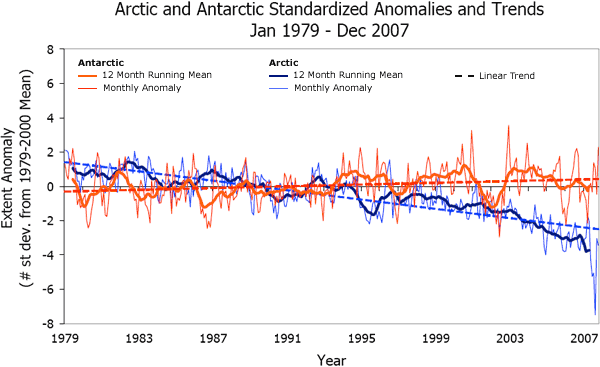bobgnote
Rookie
- Nov 24, 2008
- 1,258
- 38
- 0
- Banned
- #1
You must know government is trying to compromise on climate change, by throwing money around, when what needs to be done is to admit global warming is now dangerous enough, to justify 1. CO2-neutral biomass development, including from hemp and switchgrass, and 2. radical re-greening, of all available areas.
Since we aren't arguing, about how government is wasting money, let's end that costly drug war, RIGHT NOW, or shut up, since if you don't want an end to some war, you don't really want to save real money.
Since we aren't arguing about how Greenland's ice is melting, let's review Antarctic ice:

The continent of Antarctica has been losing more than 100 cubic kilometers (24 cubic miles) of ice per year since 2002.

The Antarctic ice sheet. East Antarctica is much higher in elevation than West Antarctica.
Let's have a look, at ALL the Antarctic ice. It seems Antarctic ice is generally on the decline:
NASA - Is Antarctica Melting?
There has been lots of talk lately about Antarctica and whether or not the continent's giant ice sheet is melting. One new paper 1, which states there’s less surface melting recently than in past years, has been cited as "proof" that there’s no global warming. Other evidence that the amount of sea ice around Antarctica seems to be increasing slightly 2-4 is being used in the same way. But both of these data points are misleading. Gravity data collected from space using NASA's Grace satellite show that Antarctica has been losing more than a hundred cubic kilometers (24 cubic miles) of ice each year since 2002. The latest data reveal that Antarctica is losing ice at an accelerating rate, too. How is it possible for surface melting to decrease, but for the continent to lose mass anyway? The answer boils down to the fact that ice can flow without melting.
Two-thirds of Antarctica is a high, cold desert. Known as East Antarctica, this section has an average altitude of about 2 kilometer (1.2 miles), higher than the American Colorado Plateau. There is a continent about the size of Australia underneath all this ice; the ice sheet sitting on top averages at a little over 2 kilometer (1.2 miles) thick. If all of this ice melted, it would raise global sea level by about 60 meter (197 feet). But little, if any, surface warming is occurring over East Antarctica. Radar and laser-based satellite data show a little mass loss at the edges of East Antarctica, which is being partly offset by accumulation of snow in the interior, although a very recent result from the NASA/German Aerospace Center's Gravity Recovery and Climate Experiment (Grace) suggests that since 2006 there has been more ice loss from East Antarctica than previously thought 5. Overall, not much is going on in East Antarctica -- yet.
West Antarctica is very different. Instead of a single continent, it is a series of islands covered by ice -- think of it as a frozen Hawaii, with penguins. Because it's a group of islands, much of the West Antarctic Ice Sheet (WAIS, in the jargon) is actually sitting on the floor of the Southern Ocean, not on dry land. Parts of it are more than 1.7 kilometer (1 mile) below sea level. Pine Island is the largest of these islands and the largest ice stream in West Antarctica is called Pine Island Glacier. The WAIS, if it melted completely, would raise sea level by 5 to 7 meter (16 to 23 feet). And the Pine Island Glacier would contribute about 10 percent of that.
Since the early 1990s, European and Canadian satellites have been collecting radar data from West Antarctica. These radar data can reveal ice motion and, by the late 1990s, there was enough data for scientists to measure the annual motion of the Pine Island Glacier. Using radar information collected between 1992 and 1996, oceanographer Eric Rignot, based at NASA’s Jet Propulsion Laboratory (JPL), found that the Pine Island Glacier's "grounding line" -- the line between the glacier's floating section and the part of the glacier that rests on the sea floor -- had retreated rapidly towards the land. That meant that the glacier was losing mass. He attributed the retreat to the warming waters around West Antarctica 6. But with only a few years of data, he couldn't say whether the retreat was a temporary, natural anomaly or a longer-term trend from global warming.
------------------------
Does anyone allege the warming will NOT accelerate, when temperatures have always been forced up, by rise in CO2, CO2 is hurtling upward, at 400 ppm, well above the usual Holocene maximum, of 280 ppm, and it is accelerating, while currently ~10x faster, than during the PETM extinction? Do you have a clue, temperature will certainly ACCELERATE, to keep up, with the jetting CO2?
If you don't believe in AGW, you can be even more ridiculous, by denying global warming. You can be worse, by denying we need to re-green, radically. You can be even worse, by alleging money is being spent, which should not be spent, on re-greening, while not properly accounting, for any money you mention. From melting Antarctic and Greenland ice, the sea level is going to RISE, during all the hedging, against global warming.
HEY. People did a lot of damage, and even if people aren't doing ALL the damage, to an environment people control, people need to fix the problem, or everybody can die.
It's like the HIV problem, back when male bath-house patrons used to trick and shoot speed, until their lethal dose migrated, all the way through AIDS, to death. The wild boys are DEAD, and the bath-houses all closed down.
Get a clue, wingnuts!
Since we aren't arguing, about how government is wasting money, let's end that costly drug war, RIGHT NOW, or shut up, since if you don't want an end to some war, you don't really want to save real money.
Since we aren't arguing about how Greenland's ice is melting, let's review Antarctic ice:

The continent of Antarctica has been losing more than 100 cubic kilometers (24 cubic miles) of ice per year since 2002.

The Antarctic ice sheet. East Antarctica is much higher in elevation than West Antarctica.
Let's have a look, at ALL the Antarctic ice. It seems Antarctic ice is generally on the decline:
NASA - Is Antarctica Melting?
There has been lots of talk lately about Antarctica and whether or not the continent's giant ice sheet is melting. One new paper 1, which states there’s less surface melting recently than in past years, has been cited as "proof" that there’s no global warming. Other evidence that the amount of sea ice around Antarctica seems to be increasing slightly 2-4 is being used in the same way. But both of these data points are misleading. Gravity data collected from space using NASA's Grace satellite show that Antarctica has been losing more than a hundred cubic kilometers (24 cubic miles) of ice each year since 2002. The latest data reveal that Antarctica is losing ice at an accelerating rate, too. How is it possible for surface melting to decrease, but for the continent to lose mass anyway? The answer boils down to the fact that ice can flow without melting.
Two-thirds of Antarctica is a high, cold desert. Known as East Antarctica, this section has an average altitude of about 2 kilometer (1.2 miles), higher than the American Colorado Plateau. There is a continent about the size of Australia underneath all this ice; the ice sheet sitting on top averages at a little over 2 kilometer (1.2 miles) thick. If all of this ice melted, it would raise global sea level by about 60 meter (197 feet). But little, if any, surface warming is occurring over East Antarctica. Radar and laser-based satellite data show a little mass loss at the edges of East Antarctica, which is being partly offset by accumulation of snow in the interior, although a very recent result from the NASA/German Aerospace Center's Gravity Recovery and Climate Experiment (Grace) suggests that since 2006 there has been more ice loss from East Antarctica than previously thought 5. Overall, not much is going on in East Antarctica -- yet.
West Antarctica is very different. Instead of a single continent, it is a series of islands covered by ice -- think of it as a frozen Hawaii, with penguins. Because it's a group of islands, much of the West Antarctic Ice Sheet (WAIS, in the jargon) is actually sitting on the floor of the Southern Ocean, not on dry land. Parts of it are more than 1.7 kilometer (1 mile) below sea level. Pine Island is the largest of these islands and the largest ice stream in West Antarctica is called Pine Island Glacier. The WAIS, if it melted completely, would raise sea level by 5 to 7 meter (16 to 23 feet). And the Pine Island Glacier would contribute about 10 percent of that.
Since the early 1990s, European and Canadian satellites have been collecting radar data from West Antarctica. These radar data can reveal ice motion and, by the late 1990s, there was enough data for scientists to measure the annual motion of the Pine Island Glacier. Using radar information collected between 1992 and 1996, oceanographer Eric Rignot, based at NASA’s Jet Propulsion Laboratory (JPL), found that the Pine Island Glacier's "grounding line" -- the line between the glacier's floating section and the part of the glacier that rests on the sea floor -- had retreated rapidly towards the land. That meant that the glacier was losing mass. He attributed the retreat to the warming waters around West Antarctica 6. But with only a few years of data, he couldn't say whether the retreat was a temporary, natural anomaly or a longer-term trend from global warming.
------------------------
Does anyone allege the warming will NOT accelerate, when temperatures have always been forced up, by rise in CO2, CO2 is hurtling upward, at 400 ppm, well above the usual Holocene maximum, of 280 ppm, and it is accelerating, while currently ~10x faster, than during the PETM extinction? Do you have a clue, temperature will certainly ACCELERATE, to keep up, with the jetting CO2?
If you don't believe in AGW, you can be even more ridiculous, by denying global warming. You can be worse, by denying we need to re-green, radically. You can be even worse, by alleging money is being spent, which should not be spent, on re-greening, while not properly accounting, for any money you mention. From melting Antarctic and Greenland ice, the sea level is going to RISE, during all the hedging, against global warming.
HEY. People did a lot of damage, and even if people aren't doing ALL the damage, to an environment people control, people need to fix the problem, or everybody can die.
It's like the HIV problem, back when male bath-house patrons used to trick and shoot speed, until their lethal dose migrated, all the way through AIDS, to death. The wild boys are DEAD, and the bath-houses all closed down.
Get a clue, wingnuts!
Last edited:








